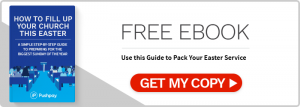
How to Increase Easter Attendance with Facebook
What role do introverts in the church play? This post explores the reasons why introverts are a crucial part of local congregations.
There’s no question that Easter is a significant Sunday with high attendance. In a 2013 survey by LifeWay Research, 41 percent of Americans planned to attend church on Easter—an increase of more than 20 percent on the average Sunday. It’s even more interesting that one in five Americans were undecided about whether or not they would attend church.
Not only do you have an opportunity to draw in the people who aren’t generally in church, but you could also have an influence on the people who are still on the fence. We want to help you create a social media strategy that will get those visitors into your church on that most important of days.
Setting Expectations
With so much contrary discussion about how churches can and should use social media, it’s probably important to make some clarifications. Here are four points you want to remember going into this post:
1. This isn’t about going viral
In preparation for this post, I read some articles intended to help churches improve their social media game. The number of them that had suggestions like “Create viral content” was staggering.
Going viral is never the goal for your social media content. If it happens, great. But it’s not very likely that you’re going to make it happen, and you can waste a lot of valuable time and effort chasing that unicorn that could be better spent on more achievable goals.
Using social media is increasingly important for helping your church reach people and improve event attendance. But that’s not the only thing your leaders should be considering, especially when trying to reach younger members of your community. See how other forward-thinking churches are using creative methods for driving Easter service attendance. Download the free ebook, How To Fill Up Your Church This Easter, today.
2. It’s not about likes and shares
While getting people to like and share your content is an important element in a good social media strategy, it’s a means and not an ends. You’ll be encouraging people to like and share your updates, but at the end of the day, you’re not looking for a magic number of interactions. Remember, our goal is to increase church attendance on Easter morning.
3. It’s going to cost some money
Facebook is a marketing tool—period. But with 1.038 billion monthly active users, there are very few places you can advertise to reach so many people in your desired audience, and Facebook intends to make you pay for that privilege.
As of April 2015, the average organic reach of Facebook pages is about 2.27–2.6 percent. That means that if you have 800 people who like your page, only about 20 people are going to see an update that you don’t pay to promote.
4. You’re going to need your congregation’s help
It’s called social media for a reason! Your church’s strategy is going to require participation from your entire church. This is one of the reasons that a lot of churches’ Facebook games struggle. You really need to explain the strategy to the whole church and communicate what you expect from them.
Using Facebook to Increase Your Easter Attendance
The goal for this (and almost any) Facebook strategy is to reach your members’ friends. That’s it. The problem is that we generally create content with the people who have already joined us on our journey in mind. We want to create content that will resonate with people who might be unfamiliar with our churches, or even with Jesus.
Here are five things you’re going to need to make this goal happen:
1. You’ll need somewhere to send them
First of all, you’re going to need a place to send people who are curious about your content. Ideally, this will be a page on your website dedicated to your Easter service. Since it will be on some images and not just in links, you’re going to want to make it easy to write out: something like, YOUR.URL.com/easter
You’re going to want this page to list out all the specifics of the service: Where is it? What time? What can they expect? Instead of a bulleted list of things you’ll have at this service like games and fun activities for the kids, brainstorm some of the objections that someone would use to talk them out of visiting it and address them.
Hint: If someone is concerned that they’re going to come and not know what’s going on, they’ll probably be more persuaded by reading that they can “experience Easter in a comfortable, laid-back atmosphere” than they will be by “FREE COFFEE!”
2. You’ll need cohesive content and strategy
If you can create your Easter service with your social goals in mind, it will help you come up with a more pertinent strategy. If you have a designer on staff or someone in your congregation that’s particularly gifted in that area, you can make all of your visual assets into an attractive package. When someone sees your updates and then clicks through to the Easter page on your website, they’re experiencing content that’s clearly associated.
You also want your strategy to be cohesive. Let’s say that your church decides to have everyone turn their profile images black from Good Friday through Easter morning. That would definitely create an opportunity for conversation.
But you want to make sure that they’re communicating one coherent message about why they’re doing so. Maybe you can give them the copy to use on their black image that says, “The days between Jesus’ death and Easter were dark and confusing for the people who had followed Jesus. Crosspoint Church is turning their profile images black in anticipation of our Easter celebration! Join us Sunday morning {{Easter page link}}.”
Whatever your strategy is, make sure you’re communicating it clearly and getting as many on board as possible.
Hint: Make sure you have changed your Facebook page’s profile and cover images to reflect your Easter theme—and make sure the Easter page URL is on your cover image.
3. You’ll need shares
Wait a second, Jayson—didn’t I already say that likes and shares aren’t the goal? Yes, I did! They aren’t the goal, but they’re an important step in attaining our objective. You want to publish some content leading up to Easter that your congregation will share. If it’s good, other people will share it, too.
Facebook is ideal for images and video. It’s no secret that churches do well on Facebook with visual quotes and scripture. Creating some images featuring quotes and verses that accent your Easter theme is smart. The idea here is to get likes and shares from people in your congregation so it will show up in their friends’ news feeds.
You’re not likely to get a lot of engagement on these posts. (We’ll get to that next.) Mostly you want to start showing up in people’s feeds, so make sure that every single piece of content has a link to your Easter page.
Hint: Think about what is meaningful to people who aren’t familiar with some of the insider Christian lingo. For instance, it’s getting to the point where terms we take for granted like “Good Friday” don’t necessarily resonate with people outside of the church.
4. You’ll need comments
If you post some content and someone shares or likes it, it will go through their friends’ news feeds. If you can get them to engage in conversation on that update, every time they comment it can potentially get recycled through their feeds. (Plus, people who get involved are receiving regular notifications.)
You’ll want to mix up your posts with some fun and thought-provoking questions that can get people talking. This is going to require some really good clarification for your congregation. The whole point of these conversations is to engage and welcome newcomers. So everyone needs to engage, and everyone needs to be on their best behavior!
5. You’ll need to pay to promote posts
Imagine a promoted post to be a hybrid between a normal Facebook post and an ad. You can take a few of your best posts and promote them beyond the people who like your page.
It’s not super expensive; you can reach 2,200–5,800 people for five bucks. That’s a pretty good return. The great part is that you can target your post to go to everyone who has liked your page (and their friends). You can also target people based on their interests, location, age, etc. I’d suggest people who like your page and their friends because that’s your best bet to keep the post in the loop of people who are close enough to actually attend.
If you have the time, test different kinds of posts at $5 each to see which ones resonate best, and then you can invest more money into the better post. If you have a post that surprised you with a great amount of engagement, you can hit the “Boost” button and promote that one as well!
Using Social Media Strategically
The important elements of this post can (and should) be used all the time. Always remember that your goal for social media is to reach people you don’t normally communicate with, and make sure your entire church is on board with the strategy.
You’ll be surprised that it is the most organic invitation tool your church has—if you’re using it right.
Discover the other ways your church can increase attendance for your next Easter service. Download the free ebook, How To Fill Up Your Church This Easter!






